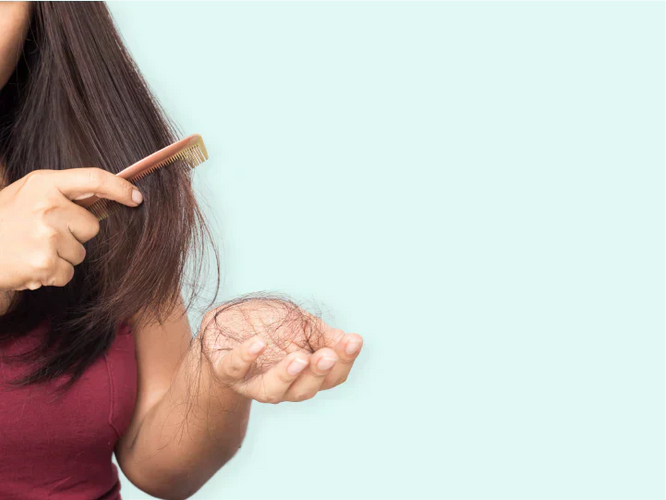- What is alopecia (hair loss)?
- Androgenetic alopecia (hereditary hair loss)
- Alopecia areata (patchy hair loss)
- Telogen effluvium
- Traction alopecia
- Alopecia totalis
- Hair loss in men and women
- How do you know which type of hair loss you have?
- Hair loss caused by illnesses or medical conditions
- Frequently asked questions about hair loss
- Conclusion
- Sources
Struggling with hair loss? You’re not alone, everyone sheds hair from time to time. However, your hair loss may be excessive, meaning you’re losing more strands than is considered normal. In this article, we explain alopecia (the medical term for hair loss), the most common causes, and key differences between men and women.
What is alopecia (hair loss)?
Alopecia is the medical term for hair loss. Sometimes hair loss is temporary and grows back; in other cases, it can be permanent. The main forms include:
- Androgenetic alopecia: often called hereditary hair loss.
- Alopecia areata: an autoimmune process targeting the hair follicle; a common cause of patchy hair loss.
- Telogen effluvium: temporary shedding when the hair growth cycle is disrupted, for example after surgery, childbirth, illness, or significant stress.
- Traction alopecia: hair loss caused by frequently wearing hair too tightly (e.g., in a ponytail or bun).
- Alopecia totalis: a rare, more severe form of alopecia areata in which all scalp hair is lost due to an autoimmune reaction.
Androgenetic alopecia (hereditary hair loss)
Androgenetic alopecia, also known as hereditary hair loss, is the most common form of hair loss in both men and women. It occurs because some hair follicles are sensitive to certain hormones. In men, DHT (a derivative of testosterone) often plays a role. This hormone can cause hairs to become progressively finer and eventually fall out. In women, hereditary hair loss often becomes noticeable around or after the menopause, when the balance of hormones changes due to a drop in oestrogen. Combined with genetic predisposition and sensitivity to androgens, this can lead to overall thinning. The pattern differs by sex: in men it often begins at the temples and crown; in women the parting typically widens and the hair on the top of the head looks thinner, while the frontal hairline is usually largely preserved.
Alopecia areata (patchy hair loss)
Have you suddenly noticed round, sharply defined bald patches on your scalp? This may be alopecia areata. It’s an autoimmune condition in which your own immune system temporarily “attacks” the hair follicles, causing hair growth to stop abruptly.
The course is often unpredictable. Sometimes a lot of hair is shed in a short time, and later it may regrow. The patches can remain small, but they can also expand. In rare cases, all scalp hair (alopecia totalis) or even all body hair (alopecia universalis) can be lost.
Alopecia areata can occur not only on the scalp but also in the beard, eyebrows or eyelashes. It is not contagious, so you cannot catch it from someone else or pass it on that way.
There is currently no treatment that cures alopecia areata completely. Because the hair follicles remain intact, there is always a chance that the hair will regrow spontaneously.
Telogen effluvium
Telogen effluvium is a temporary form of hair loss where more hairs than usual fall out suddenly. This happens when many hair follicles enter the resting phase of the hair growth cycle earlier than they should. This is called the telogen phase.
In this phase, the hair no longer grows and prepares to shed. When the body experiences a disturbance, more hairs than normal can move into this phase. Common triggers include a period of high fever, surgery, childbirth, severe stress or a change in medication.
Telogen effluvium usually causes even hair loss across the entire scalp, without clear bald patches. Because the hair follicles remain intact, the hair can grow back naturally once the cause has passed. If the hair loss lasts for a longer time, it may be called chronic telogen effluvium.
Examples of triggers for telogen effluvium
- Fever
- Surgery
- Childbirth
- Severe stress
- Starting of changing medication
Traction alopecia
Do you often wear tight braids, ponytails or extensions? Or regularly wear a tight headscarf, cap or helmet? If so, you may develop traction alopecia.
This type of hair loss is caused by prolonged pulling on the hair. Constant tension overloads the hair follicles. Early on, shedding tends to occur along the hairline or at the temples, exactly where the pressure is greatest.
The good news: in its early stages, traction alopecia can fully recover if you remove the tension and give your hair a rest. However, if the pulling continues for years, the follicles can become permanently damaged, and hair may not grow back.
Prevention matters. Vary your hairstyles, avoid wearing your hair tightly pulled back every day, and opt for looser or softer accessories. If you have symptoms, consult a clinician for personalised advice and possible treatment.
Alopecia totalis
Alopecia totalis is a rare, more severe form of alopecia areata. In this condition, all scalp hair is lost due to an autoimmune reaction that attacks the hair follicles. It may start with small round patches that rapidly expand, or the scalp hair can appear to disappear almost all at once. If eyebrows, eyelashes and other body hair are also lost, this is called alopecia universalis.
Hair loss in men and women
Hair loss affects both men and women, but it often looks different. Let’s look at the key differences and underlying causes.
Differences in pattern and cause
Men hair loss typically starts at the temples and crown. The hairline gradually recedes, and thinning follows a recognisable pattern. In women, it usually begins on the top of the scalp: the parting widens and overall volume decreases. The frontal hairline often remains intact. In women, sensitivity to hormones such as DHT tends to be more pronounced around the mid-scalp, which is why thinning is most noticeable there. Why the hairline is usually preserved is not fully understood.
Hormones play a role, but not always in the same way. In men, a genetic sensitivity to DHT causes hairs to regrow progressively finer. In women, hair loss often becomes more noticeable during life stages such as post-pregnancy or the menopause. Nutritional deficiencies (e.g., iron deficiency) or thyroid problems can also contribute. This can make it harder to pinpoint a single primary cause in women.
Note the difference between thinning hair and increased shedding:
-
Thinning happens gradually and is typical of hereditary hair loss. Hairs become finer and follow a set pattern: in men this is most visible at the temples and crown; in women, mainly on the top of the head.
- Sudden, diffuse shedding across the scalp is more characteristic of telogen effluvium. It usually appears two to six months after a trigger such as fever, surgery, childbirth, stress or a change in medication. It occurs in both men and women and is generally temporary.
How do you know which type of hair loss you have?

Infographic: Recognise different types of alopecia
Hair loss caused by illnesses or medical conditions
Sometimes hair loss is not caused by alopecia itself, but is a symptom of another condition in the body. This can happen with thyroid problems, iron deficiency, autoimmune diseases or long-term infections. A lack of certain nutrients or side effects from medication can also lead to general hair thinning.
In addition, some local scalp conditions can cause hair loss, such as:
- Tinea capitis (ringworm): a fungal infection that causes round, scaly bald patches.
- Lichen planopilaris: an inflammatory condition of the hair follicles that can lead to scarring.
Depending on the cause, the hair loss may appear across the entire scalp or be limited to certain areas. Recovery largely depends on the underlying condition and how quickly it is treated.
Frequently asked questions about hair loss
How much hair loss is normal?
On average, you shed around 50 to 100 hairs a day. If you’re consistently losing more than this, you may be experiencing excessive hair loss.
What is DHT and why does it matter?
DHT (dihydrotestosterone) is formed from the hormone testosterone. If your hair follicles are sensitive to DHT, it can lead to androgenetic (hereditary) hair loss by causing hairs to grow back progressively finer.
What is the difference between telogen effluvium and illness-related hair loss?
Both telogen effluvium and hair loss caused by illness can appear as thinning across the whole scalp. However, they work in different ways and recover differently.
With telogen effluvium, the hair follicles are temporarily disrupted by an event in the body. The roots stay healthy, so the hair usually grows back on its own once the body has recovered.
With illness-related hair loss, the cause lies deeper. A thyroid problem, an autoimmune reaction or inflammation of the scalp can affect the hair follicles for a longer period of time. As a result, the hair may grow back more slowly or not fully recover.
Conclusion
Hair loss can have many different causes: from hereditary forms such as androgenetic alopecia to temporary triggers like stress or illness, and sometimes as a symptom of an underlying condition. The pattern and severity vary from person to person and situation to situation. Often hair loss is temporary and regrows on its own, but in some cases it can be permanent. If you notice sudden shedding, a change in pattern, or other symptoms, it’s wise to consult a general practitioner or a dermatologist for assessment and advice.
Sources
British Association of Dermatologists – Patiënteninfo alopecia areata en “living guideline” (BJD, 2025). bad.org.uk/pils/alopecia-areata
This information does not replace professional medical advice. If in doubt, always consult a doctor or specialist.













